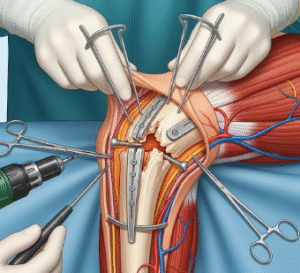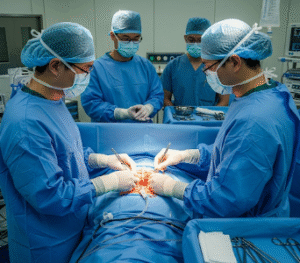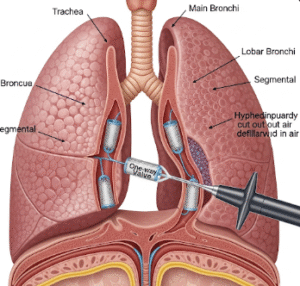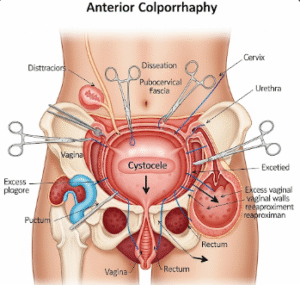What it is
Midurethral sling surgery is a minimally invasive surgical procedure used to treat stress urinary incontinence (SUI)—a condition where urine leaks during activities such as coughing, laughing, sneezing, or exercising. The procedure involves placing a small strip of mesh or synthetic tape under the urethra to provide support and prevent leakage.
In Korea, this surgery is widely performed in women’s hospitals and urology centers using the latest surgical techniques, ensuring high success rates, minimal discomfort, and faster recovery.
➡️ Key points about midurethral sling surgery:
- Provides long-term relief from stress incontinence
- Minimally invasive, usually performed under local or regional anesthesia
- Considered the gold standard treatment for stress urinary incontinence worldwide
Why it’s done
This surgery is performed to treat women who suffer from stress incontinence that does not improve with conservative treatments like pelvic floor therapy.
✔️ Medical reasons include:
- Frequent urine leakage during physical activity or exertion
- Failure of non-surgical options such as pelvic floor exercises or medications
- Quality of life significantly affected by embarrassment, hygiene concerns, or lifestyle limitations
✔️ Benefits of midurethral sling surgery:
- High success rates (80–90% of women experience significant improvement)
- Minimally invasive with small incisions and quick healing
- Long-lasting results compared to injections or medications
- Restores confidence and social participation
Alternatives
Before recommending surgery, doctors often suggest less invasive treatments.
🔹 Pelvic floor therapy:
- Kegel exercises and biofeedback to strengthen pelvic muscles
- Works for mild incontinence but not always effective in moderate to severe cases
🔹 Medications:
- Limited role in stress incontinence (more useful for urge incontinence)
🔹 Injections (urethral bulking agents):
- Temporarily thicken the urethral wall to reduce leakage
- Less durable than sling surgery, requiring repeat treatments
🔹 Lifestyle changes:
- Weight loss, fluid management, and avoiding bladder irritants
- Helps reduce symptoms but rarely solves severe incontinence
Preparation
Proper preparation ensures safety and successful outcomes.
➡️ Medical preparation:
- Urodynamic testing to confirm diagnosis and rule out other bladder conditions
- Urine tests to exclude infections
- General health evaluation and discussion of anesthesia options
➡️ Personal preparation:
- Stopping blood-thinning medications as instructed
- Fasting if general anesthesia is planned
- Arranging for help at home for the first few days after surgery
➡️ Mental preparation:
- Understanding realistic expectations (majority improve, but some may still have minor leakage)
- Counseling to reduce anxiety about surgery
- Preparing emotionally for temporary activity restrictions after the procedure
How it’s done
Midurethral sling surgery in Korea is performed using highly standardized and precise techniques.
✔️ Step 1 – Anesthesia
- Local, spinal, or general anesthesia depending on patient preference and hospital protocol
✔️ Step 2 – Making incisions
- A small incision is made inside the vagina beneath the urethra
- Tiny incisions may also be made in the groin or lower abdomen, depending on the sling type
✔️ Step 3 – Inserting the sling
- A strip of synthetic mesh or tape is placed under the mid-portion of the urethra like a hammock
- Sling supports the urethra, preventing leakage during pressure increases
✔️ Step 4 – Adjustments and closure
- Sling tension adjusted to avoid over-tightening
- Incisions closed with dissolvable sutures
✔️ Types of sling techniques:
- TVT (Tension-free Vaginal Tape): Sling passed through a small abdominal incision
- TOT (Transobturator Tape): Sling passed through groin incisions, reducing risk of bladder injury
- Mini-sling: Newer method requiring fewer incisions and faster recovery
✔️ Duration:
- Surgery usually takes 30–60 minutes
- Many patients go home the same day or after one overnight stay
Recovery
Recovery after sling surgery is usually quick, but some precautions are necessary.
➡️ Immediate recovery:
- Mild vaginal bleeding, discomfort, or pelvic pressure for a few days
- Bladder function checked before discharge to ensure proper emptying
➡️ Physical recovery:
- Return to light activities in a few days
- Avoid strenuous exercise, heavy lifting, and sexual activity for 4–6 weeks
- Full healing usually within 6 weeks
➡️ Emotional recovery:
- Relief from leakage improves confidence and quality of life
- Some women may need reassurance if mild leakage persists temporarily
➡️ Key recommendations:
- Adequate rest and hydration
- Pain medication if needed
- Follow-up visits to check healing and sling placement
- Report any difficulty urinating or persistent pain immediately
Treatment option in Korea
Korea is a leading destination for urinary incontinence surgery, including midurethral sling procedures.
✔️ Hospital facilities:
- Equipped with advanced surgical instruments and monitoring systems
- Specialized women’s hospitals and urology centers focusing on incontinence care
- Outpatient or short-stay services for patient convenience
✔️ Medical expertise:
- Surgeons with high success rates and extensive experience in sling procedures
- Personalized approach in choosing TVT, TOT, or mini-sling based on patient’s anatomy and condition
- Use of safe, biocompatible sling materials to reduce complications
✔️ Postoperative care:
- Integration of pelvic floor therapy for enhanced outcomes
- Regular follow-up to monitor bladder function and long-term results
- Counseling and lifestyle support to prevent recurrence
✔️ Cultural aspect:
- In Korea, urinary incontinence is openly addressed as a women’s health priority
- Hospitals emphasize privacy, dignity, and holistic care
- Women are encouraged to treat incontinence early rather than endure it silently
➡️ Highlight: Midurethral sling surgery in Korea provides safe, effective, and minimally invasive treatment for stress urinary incontinence, ensuring long-lasting relief, improved quality of life, and comprehensive recovery support.













